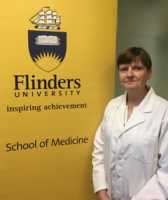24 Mar ALS: Urinary p75ECD as a Prognostic, Disease Progression, and Pharmacodynamic Biomarker
MedicalResearch.com Interview with:
Mary-Louise Rogers, PhD
Senior Research Fellow, Lab Head,
Motor Neurone Disease and Neurotrophic Research Laboratory,
Department of Human Physiology,
Centre for Neuroscience,
Flinders University, School of Medicine,
South Australia, Australia
MedicalResearch.com: What is the background for this study? What are the main findings?
Response: ALS is a fatal neurodegenerative disease in which motor neurons, cells that control muscle activity such as walking, talking and breathing, gradually die off, resulting in paralysis. There is no cure for ALS.
In a groundbreaking study published in the journal Neurology, and led by Mary-Louise Rogers, Ph.D., senior research fellow at Flinders University, Australia, and Michael Benatar, M.D., Ph.D, University of Miami, Miller School of Medicine, have identified concentrations of p75ECD, the extracellular domain on the common neurotrophin receptor p75, as the first biological fluid-based biomarker for ALS progression. .
Neurotrophin receptor p75 is a growth factor receptor for neurotrophins whom promote the survival of nerve cells. Under normal circumstances, it is highly expressed on motor neurons during development but decreases after birth. Following nerve injury, however, the expression of p75 is increased and the extracellular domain of p75 is detectable in urine. Dr Rogers and her Doctoral student Stephanie Shepheard hypothesized and then showed, that p75ECD is excreted into the urine of SOD1 mice, the most commonly used animal model of ALS. These findings empowered further investigation of p75ECD, showing raised levels in the urine of patients with ALS and that it might have potential as an ALS biomarker.
Dr Rogers and Prof Benatar then went on to develop a collaboration that included Dr Rogers doctoral student Stephanie Shepheard, and their clinical colleague at Flinders, David Schultz, M.D., and Joanne Wuu (Miami University). In their Neurology paper they showed for the first time, a biological fluid-based biomarker – urinary concentration of p75ECD increases as disease progresses in ALS, and raises the possibility that p75ECD could also serve as a marker of pharmacodynamic effect in future treatment trials. Moreover, the level of p75ECD at the time of initial study assessment appears to predict the future course of disease. The finding provides a quantifiable measure of the severity of motor neuron degeneration in ALS and suggests it could be used in clinical trials.
MedicalResearch.com: What should readers take away from your report?
Response: Measuring urinary p75ECD in ALS patients that are part of a future clinical trial of new treatments has the potential to transform the conduct of clinical trials, making it easier to decide which experimental therapies are worthy of further investigations.
MedicalResearch.com: What recommendations do you have for future research as a result of this study?
Response: We hope to start to test the hypothesis that urinary p75ECD in ALS patients is a pharmacodynamic marker in a range of future trials and also to continue to test the marker in larger studies across different sites across the USA, Australia and Europe.
MedicalResearch.com: Thank you for your contribution to the MedicalResearch.com community.
Citation:
Neurology. 2017 Mar 21;88(12):1137-1143. doi: 10.1212/WNL.0000000000003741. Epub 2017 Feb 22.
Urinary p75ECD: A prognostic, disease progression, and pharmacodynamic biomarker in ALS.
Shepheard SR1, Wuu J1, Cardoso M1, Wiklendt L1, Dinning PG1, Chataway T1, Schultz D1, Benatar M2, Rogers ML2.
Note: Content is Not intended as medical advice. Please consult your health care provider regarding your specific medical condition and questions.
More Medical Research Interviews on MedicalResearch.com
[wysija_form id=”5″]
Last Updated on March 26, 2017 by Marie Benz MD FAAD

